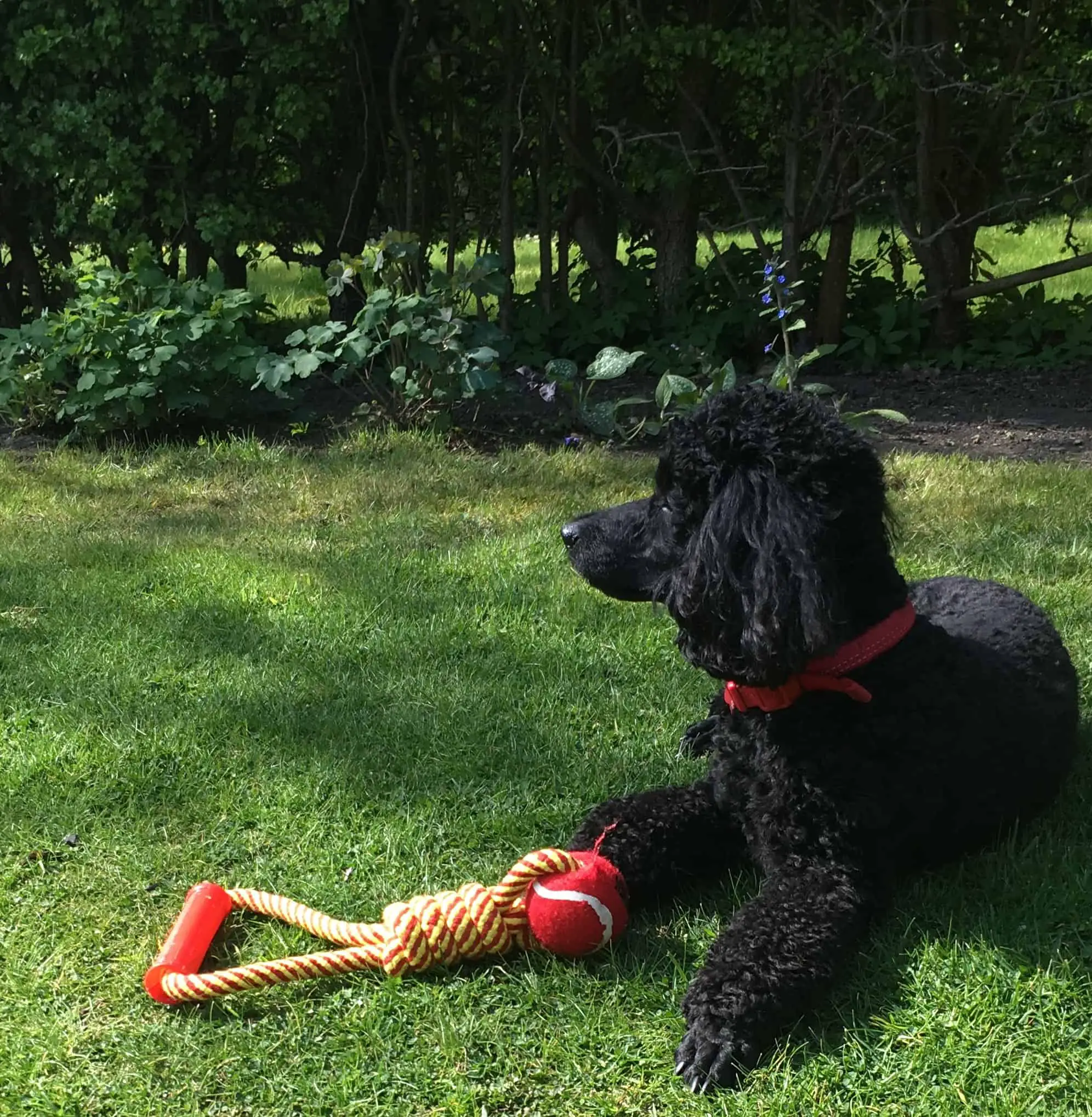How Long Do Poodles Live In Human Years? A New Mathematical Formula Can Help You Find Out

Many poodle owners, especially children, love to think of their dog’s age in human years- it allows them to really know how old their dog is- are they a child, teenager, middle-aged, or getting old…
So, in general, people normally equate 1 dog year= 7 human years. So a 1-year-old dog would be around 7 years old and still a child, a 2 ½-year-old dog would be a 17 year old and an 8-year-old dog is around 56 in human years. This is obviously not an exact science but can be a helpful guide to imagine your poodle’s life span and stages. For example, you can expect a 2-year-old or “teenage” poodle to have a lot more energy than a 10 year old “70-year-old” and so on.
Poodles live to between 84 and 105 in human years. The average lifespan of a poodle is 12-15 real years, so times these numbers by 7 and you get the average human years lifespan of a poodle!
So just think if your poodle lives for 15 years, they are the equivalent of 105 years old in human years- which is a pretty long lifespan for any dog.
Calculating your Poodle’s Human Age
Alongside the typical 1 dog year= 7 human years there is also another formula that is becoming popular to determine your poodle’s age in human years. This uses a bit more science compared to the simpler formula but may be worth calculating if you want to get a better idea of what age your dog is in human years. However, you will need a scientific calculator for this one!
Researchers have developed a new way to convert dog years into human years. A bit more science is used compared to the more well-known and popular formula.
This new formula can be used on dogs who are one year old and older. According to the formula, the human age of a canine is roughly equivalent to 16 x ln(dog’s age) + 31.
In order to work out what the ‘human’ age is for your dog. First, enter his age. Next press the ‘In” button on a scientific calculator.
Multiply that number by 16, and then add 31.
When this formula is used, a ten-year-old dog is 67.8 in human years, a five-year-old dog is 56.8, and a two-year-old dog is 42.1. So have some fun working out your poodle’s age in human years- if you have kids you could even turn it into a fun maths lesson!
Poodle Lifespan and Size
One of the most mysterious aspects of canine lifespan is the old idea that the lifespans of bigger dogs are shorter than smaller dogs. However, that is a very general and broad statement that this article will debunk in detail, and how it relates more to the Poodle breed and different sizes.
Although statistics have offered proof for the theory ‘size affects lifespan,’ animal biologists, as well as other types of animal specialists, are taking a closer look to understand this theory better. In the past, it was widely believed that more work had to be done by a bigger dog’s body, such as pumping blood in a larger body, etc. However, that is debatable since larger dogs also have larger hearts. Was that the only reason? It appears not to be.
German researchers conducted a study where they collected data from more than 56,000 canines, including from 74 breeds. Their results were somewhat surprising. Although they concluded that bigger breeds (such as the Standard Poodle) had shorter life expectancies compared to small breeds (such as the Toy Poodle), it was suggested by the data that bigger dogs aged at an accelerated rate. What this actually means is that a lot of diseases (cardiovascular disease, cancer) strike bigger dogs, like the standard poodle, many years before they impact smaller dogs, like the toy poodle.
Also, Musculoskeletal problems (arthritis, joint problems) and Gastrointestinal issues (inflammatory bowel disease, pancreatitis) have a tendency to affect the bigger Standard Poodle more quickly than it affects the smaller Toy Poodle.
Keeping all this in mind, note that there are many different exceptions to this. A small Toy Poodle could become ill and only live 9 years, while a big Standard Poodle could remain in great health well beyond ten years.
Life Expectancy For Every Size of Poodle
Toy Poodle Life Expectancy – The normal lifespan range is 14 to 16 years, with a 15-year median lifespan.
Miniature Poodle Life Expectancy – The normal lifespan range is 14 to 16 years, with a 15-year median lifespan.
Standard Poodle Life Expectancy – The normal lifespan range is 11 to 13 years, with a 12-year median lifespan.
Klein/Moyen Poodle Life Expectancy – The normal lifespan range is 12 to 15 years, with a 13.5-year median lifespan.
As you can tell from above, the life expectancy of the Miniature and Toy Poodles are the same, with the Standard Poodle having a slightly shorter lifespan. The European-sized Klein/Moye falls in between. This reflects wider data about how size relates to lifespan across a large number of dogs, with bigger poodles like the Klein and Standard poodle having slightly shorter lifespans.
It is unfortunate that the lifespans of canines are not as long as humans, since our pets are considered to be members of our family, and it is an incredibly heartbreaking experience to lose any dog as they are part of the family! However, there are numerous steps that owners can take that will help to extend the lifespan of their Poodles.
How to Give Your Poodle the Best Chance of a Long Life
Although these steps should being while a toy poodle, miniature poodles and standard poodle is still a puppy so all the benefits are reaped, it’s never too late to get started!
1. Give your Poodle the healthiest best quality food that you can afford. I cannot emphasize enough how unhealthy some cheap, manufactured dog food is for your poodle. Many contain too much grain, preservatives, artificial flavors, artificial coloring, and fillers. In the very worst-case scenarios, with the lowest quality commercial dog food, it can contain things like non-meat parts from cattle, sheep, pigs, and chicken (these parts can include diseased livers, tumors, udders, lungs, and other nasty and shocking elements, ‘downers’ (animals that were considered to be too injured or ill to be slaughtered to use for human consumption), and dead animals.
2. Be Aware of What Water Your Poodle Is Drinking. This is something that many owners don’t really think about. When it is time to fill up their dog’s water bowl they just turn the kitchen tap on. However, when you do that you could be filling the water bowl up with nasty elements that could be harmful to your dog’s health and could potentially shorten your pet’s lifespan as well. n numerous areas, legal limits of bacteria, pesticides, and factory run-off are found in the tap water. Over a Poodle’s lifetime, you never know what horrible effects they could have and the diseases that could result from ingesting them for years. So play it safe and install a filtering system onto your kitchen tap.
3. Brush Your Dog’s Teeth. Tooth decay not only brings the real potential of an infection entering into your Poodle’s bloodstream but when an old dog has decayed teeth or loses his teeth, it can reduce his overall quality of life and lead to painful teeth and mouth issues.
4. Exercise your Poodle. A well-exercised dog is a healthy dog! Poodles are not intended to lead sedentary lives and generally have lots of energy that needs to be burned off. It is strongly recommended that your dog get daily moderate exercise and a good run around. However, excessive exercise could be harmful (i.e. strenuous walking in hot weather without resting in the shade of taking a break for water, etc.), and for Toy Poodles, in particular, jumping from heights could lead to back, hip, knee, and/or leg issues.
5. Visit the vet on a regular basis for checks and the first sign of any health problems, do not wait until a problem becomes serious before taking your poodle to the vet. Many dogs have died prematurely due to the fact that a problem was not caught during the early stages when the dog’s life could have been saved by medical intervention.
All if these tips are very common sense so I hope they are helpful. Luckily most toy poodles, miniature poodles and standard poodles have a long life expectancy on the whole and most will live at least 11 years, compared to some dog breeds, such as mastiffs, whose average life expectancy is only around 8 years.

